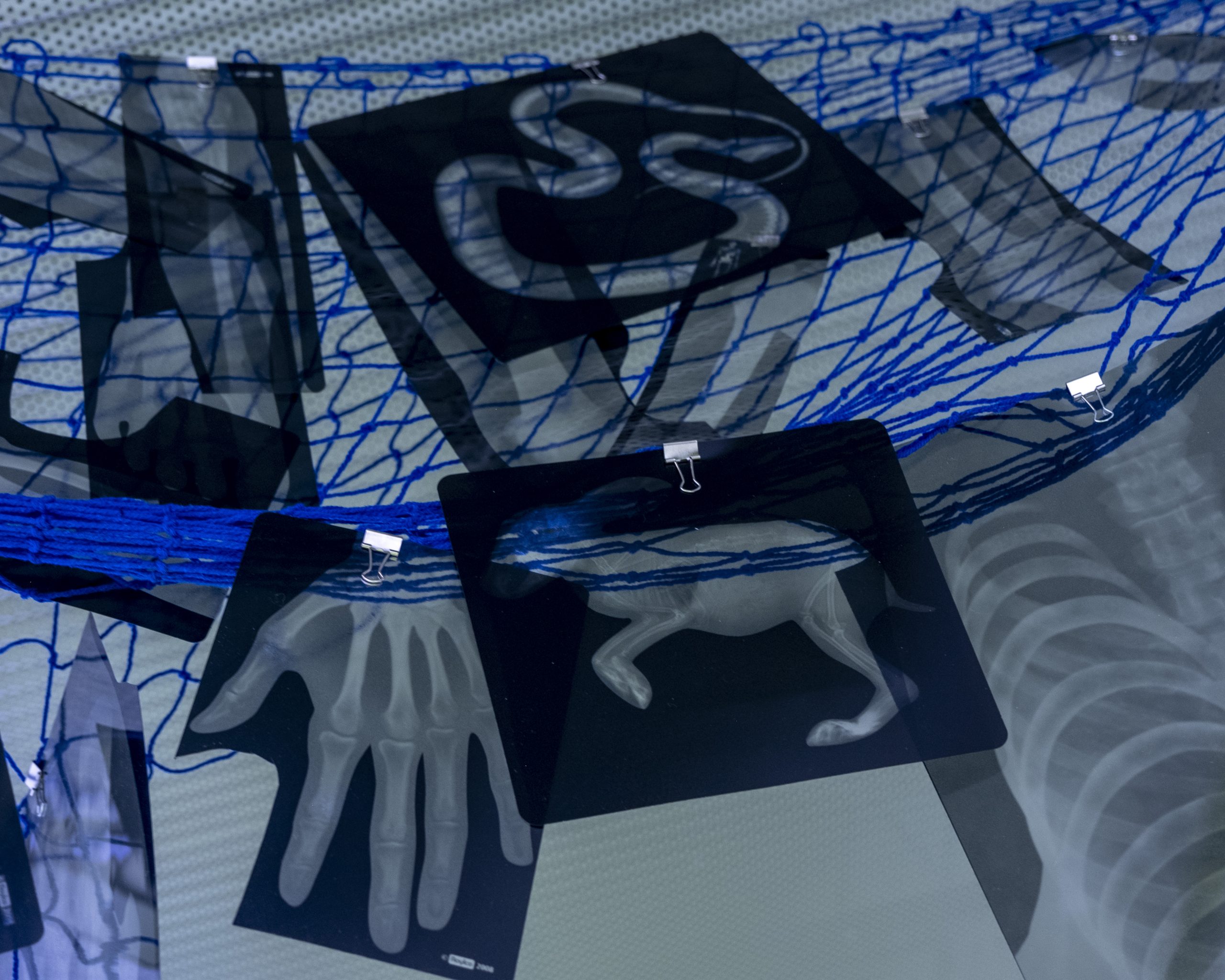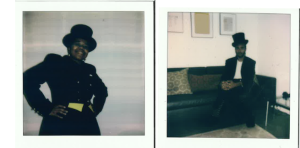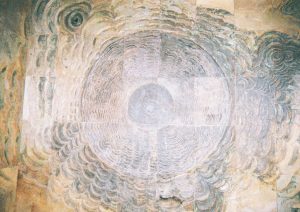Featured image: A.J. McClenon, Evolving, Devolving and Escape Studies, 2021. X-rays of various objects laying on nets. Dimensions vary. Photo by Arda Asena, courtesy of curator Gervais Marsh.
We are living in a strange, strange time. A time when our bodily atoms are swimming upstream against a current riddled with a virus content on destroying us. A time when loved ones near and far are transitioning from this earthly realm on a grand scale. A time when our collective and individual grieving processes seem to be magnified through a spyglass. All the while, still coupled with the crushing relentlessness of capitalism; the expectation that even though our world is crumbling the motive is always towards a profit. Most of us aren’t swimming, we’re flailing. Efforting to cast our nets knotted with a steadfast tenacity and building our lifeboats made of possibility and prayer to keep us adrift. But at last, there’s an extraction point. A black w(hole). A message in a bottle floating towards us; not one of distress but one of assurance that there is hope on the other side. We’ve arrived at Notes from VEGA at the Hyde Park Art Center. Steeped with love and admiration in every direction, visual and performance artist A.J. McClenon invites us through the looking glass to excavate the depths of our shared memories as a method for understanding and re-envision how, through our everyday rituals, through our weathering of the storm, through our process-driven reckoning, we can assemble new ecologies of survival in the most ominous of times.
Floating through the gravitational eddy that Notes from VEGA evokes, you encounter objects given an artifact quality through their indeterminable location in time. Is this from the year 2000? Was this written account from tomorrow? When am I? Over the span of ten nonlinear years, McClenon has intentionally constructed the VEGA series narrative. Describing the series, McClenon writes, “In the year 2112, 63 years after the Post-Post-Post movement, the government plans to execute its Universal Relocation Project (URP), leaving earth in a machine large enough and fast enough to orbit a black hole. Meanwhile, three leading Black physicists Vega, Dr. Kramoris (aka D’Ram), and Dr. Dahnara Bekti (aka Nara), work together undercover with the Futurist Freedom Party (FFP) to secure technology for human life in Earth’s deep oceans for citizens left behind.” Alongside Christina Sharpe, Alice Walker, and Legacy Russell, McClenon cogitates on the use of “weathering”, of “everyday use”, of the “glitch/error” as a place to contend with the normalcy that supports the interconnected levee of environmental destruction, capitalism, and anti-Black violence. Assembling everyday materials of Black life from organic and inorganic matter, McClenon tethers us to a life raft that wades in the waters of their non-conclusive offerings of observation and introspection.
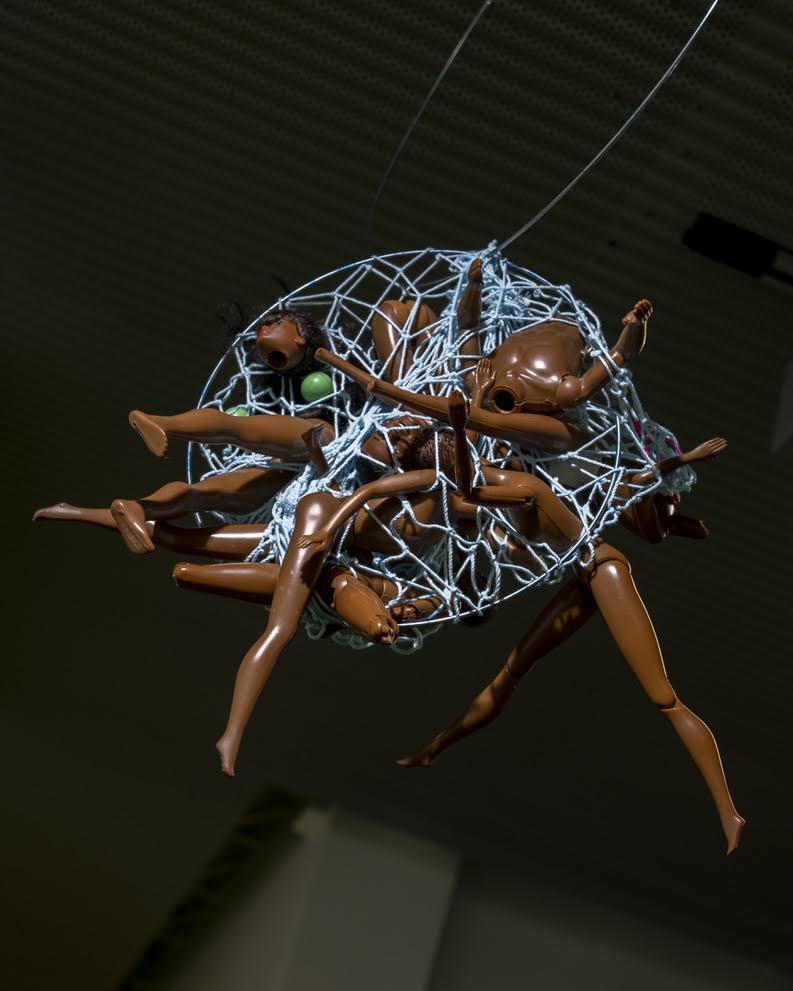
isra rene: I understand your work as rooted in place: in space, in water, in the void, etc. It is rooted in how these sentient points can provide an emergent perspective to reimagine our lived realities and other realities not lived yet. Can you talk about your understanding of the importance of place in your work?
A.J. McClenon: Well, as a lot of people may know, I am quick to say that I am from D.C. proper. I didn’t realize how much I loved it until I left. It’s not just that we could go a couple of weeks only seeing other Black people and POCS, but in the early 90s, it had a small-town feel. Everyone’s grandma was from the Carolinas mostly and other places in the south so they were all on committees together, everyone knew everybody on the block and so a sense of a multigenerational household stretched into the neighborhood, at least for where I grew up in Riggs Park. This sense of community as an extended family at an early age makes you feel a boundless kind of love. I’d accidentally lock myself out after coming home from school and could just knock on Mrs. Mills’ door and go watch MTV and she’d give me a pound cake from the freezer to give to my family on the way out. I imagine this space of generosity and love transported anywhere and know that these spaces exist beyond Riggs Park. Knowing the possibilities of a place means that it can happen anywhere. In my work VEGA, it’s in the deep ocean.
Outwardly benign but deeply impactful gestures of loving-kindness that McClenon orbited in their family and community are the same gestures reaching back out to you from the work. These diurnal gestures and objects that McClenon centers in the work inherently refuse what Curatorial Fellow Gervais Marsh describes as a “Black Spectacular”. On the expectation of a “Black Spectacular,” Marsh contends, “So much of the work that Black people create is framed under the spectacular, particularly when its to be marketed to a mass public or through an institution then there is a spectacularity that is pushed even if the artist isn’t framing it as such — it becomes co-opted. Sometimes it can be hard to push back against that dominant narrative because it’s the spectacular that people want in order to promote the work or to get the show. It’s so frustrating constantly pushing back against this demand for spectacularity. So much beauty happens in the everyday.” Marsh continues with insertions of the unique mediations that Notes from VEGA offer to the conversation of ritualistic everyday-ness. “There are so many things that Black people do that engage with the everyday ritual and it’s talked about with seriousness. It’s not a new thing to theorize and critically engage with everyday rituals. Everyday-ness or ritual has been experienced as an important contemplative, reflective, and meditative time. A lot of A.J.’s work allows that for that time. From braiding of the hair, creating the collages, and tying the neon fishing line, so much of the work is meditative. Towards the end of the installation, A.J. talked about their relationship to fishing and about how they would go fishing with their mother’s late partner and the time they spent with him, and what that meant to them. Notes from VEGA uses materials thinking about fishing — and not just thinking about fishing as it pertains to the ocean, but about the meditativeness of fishing. A.J. talked about how they went fishing every weekend, how they spent the entire day and night on the bridge to catch catfish. These moments deeply enriched A.J.’s outlook on life — the ritual of fishing. “There are so many rituals in Black diasporic life that we’ve always taken seriously and I think it’s really beautiful to think about.”
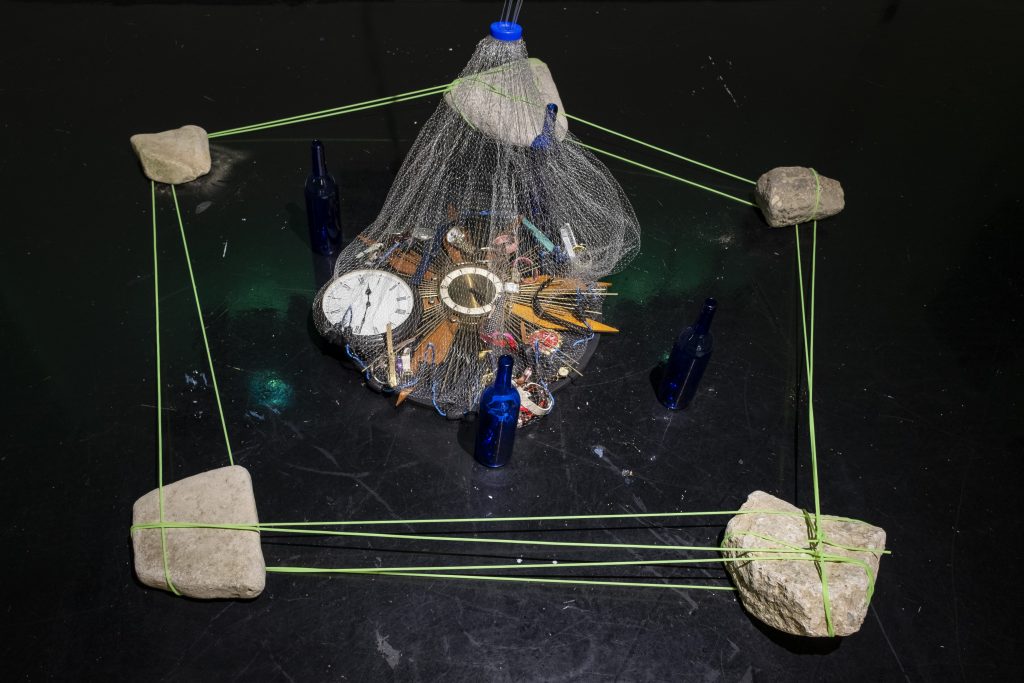
Notes from VEGA encompasses a range of mediums including installation, collage, video, writing, and performance. Through the use of everyday objects specific to the aesthetics of Black life, McClenon points to the utility that Black people have historically centered: we are and will always be the architects of our past, present, and future. We have the keys we are the keys to unlock the treasures that live in the depths of outer space and sea.
“Down, down, baby, down down by the rollercoaster.
Sweet, sweet baby, I’ll never let you go.
Shimmy, shimmy cocoa pop, shimmy, shimmy pow …”
Meandering my way through the exhibition, this infamous rhyme loops in my mind, chanting to me in the same encouraging fashion that childhood friends used to generate joy, participation, and a togetherness — if only for that moment in time. With a childlike curiosity, I submit to the request for meditation and an unforced type of focus that the exhibition requires. Notes from VEGA lends itself to a playful approach in the ways that McClenon utilizes the space. In the tunnel-like corridor of the second floor of the Hyde Park Art Center, you sense the pondering with conformity that McClenon is grappling with. Drawing (from) outside the lines coupled with the comparatively careful placement of each object in the space, Notes from VEGA shifts your attention to ways of revisioning seemingly inflexible structures with a pleasurable practicality.
Kanekalon braiding hair extensions are loosely woven with neon green fishing string creating nets and cording that drape the walls and ceiling; reminiscent of jump ropes used in Double Dutch that Black children have used as a pastime and sport. Fishing leaders, hooks, wire, and stones sourced from Lake Michigan form literal and metaphorical anchors that secure you to the weight of wonder and hope that you clung to as a child. Throughout the exhibition, large black t-shirts, Jordans, durags, and silver chains hauntingly recall their simultaneous use as adornment and reverence. Drawings, collages, and journal entries operate as an intimate data collection scavenging the integral role that attention to daily processes mediates in the mode of Black futurism. Together with their relationship and witnessing of each other, these materials blur the line between art objects / aesthetic or utility products. And, while highlighting the domestic object as an art object is not a new configuration, there is a fascinating distinction to be made for McClenon’s arranging and use of the work and of the(ir) body. Rather than acquiescing to the normality of the oftentimes stale gallery space, McClenon weaves the spiritual connection of each object with the transitional space of play to ruminate over the generous ancestral coding in our everyday practices and objects. In this recognition, we unearth the generative tools and emotional stamina it takes to fortify not only the survival but also the livelihoods of Black people in all dimensions and directions of time.

ir: When engaging with your work, there’s a cosmic object design that is sensed; each object is activated and given new meaning when joined with another. Can you talk about the importance of meaning-making or making meaning in your practice within the VEGA series in general?
AM: Forever I’ve recognized the spiritual potentiality of objects. For many reasons. My family is huge on repurposing so an object always has a purpose even when its initial purpose of use can no longer be considered. Being wasteful was truly an atrocious act. You used things multiple times and ate everything even if that meant putting less than a handful of lima beans in the fridge for a snack the next day. Objects are also about capitalism. Wanting things. Desiring. And those desires become mixed up with all the memories placed on them. So you have objects with love poured or maybe lust plus personal meanings and eventually cultural or political meanings or both. And so in my work, when I am merging these objects to create something new, it’s recognizing or highlighting a relationship that’s already there through memory, desire, culture, and all that. For instance in VEGA, when I create a wormhole using crab baskets and hair extensions, I am thinking about the history of cornrows used as secret maps that enslaved Africans used to run from the plantation, but I am also thinking about getting my own hair cornrowed by my grandma or the neighbor’s teenage daughter or from the Jamaican woman at the shop who turned me onto coco bread. These memories weren’t about an escape necessarily, but acts of intimacy, long Saturdays, and different hands across the diaspora; where previous escapes have led us today. And then the crab baskets have both a memory attached from growing up eating crabs every summer in D.C., but also there’s a beauty to them when repurposed and giving them a shape when stacked and then suspended from the ceiling. People have been using objects to make art forever because, in many ways, they are beautiful. So by fusing these memories, shapes, and histories, I get a wormhole into the future the same way each of these objects are born again into new futures.
In performance, McClenon renders another type of generosity that rarely feels realized within institutional spaces. They employ performance as a (space) ship to share an embodied detailed account of what it means to be transported through the ushering of a deep ancestral technology. A technology that provides for revelations. A technology that opens portals towards a world made anew through reclamation. Through the soundscape of their ghostly harmonica and playback loops of a prominent D.C. Native congo drum player, there is a crescendo that takes place. Accompanied with the mesmerizing footage of McClenon’s own deep sea diving, you are submerged.
ir: As my D.C. native kin, I would love to know the ways that gogo music and the gogo scene, in general, has influenced your practice within sound and with the VEGA series?
AM: The inherent improvisational aspects of gogo has been such a real influence. Also, gogo feels so punk too and how the vocalists go on tangents and riffs reminds me a lot of how Fela Kuti talked about how African music isn’t confined to ideas of time. You also have the call and response parts of it and so everyone is involved. Seeing so many Black people play instruments live outside of genres like rock or whatever made the music feel more accessible. Like, you got folks playing the guitar, the bass, the congos, and all kinds of drums and percussion and it’s all so hood, so spiritual, and sometimes even sexy. The vocalist often sounds like someone you know talking back and forth at you and in a lot of the old recordings of live gogo you can hear the audience responding and they are forever a part of the song. Once again it’s a community thing and a community sound. You have Black people in a Black city, it was still Chocolate city back then, piecing together all these sources to make a very Black sound. It’s a real sonic collage that exalts the present moment and a very here-and-now collaboration.
So with my own practice, I try to keep that spirit of improvisation and piecing together many parts, which to me feels like play.
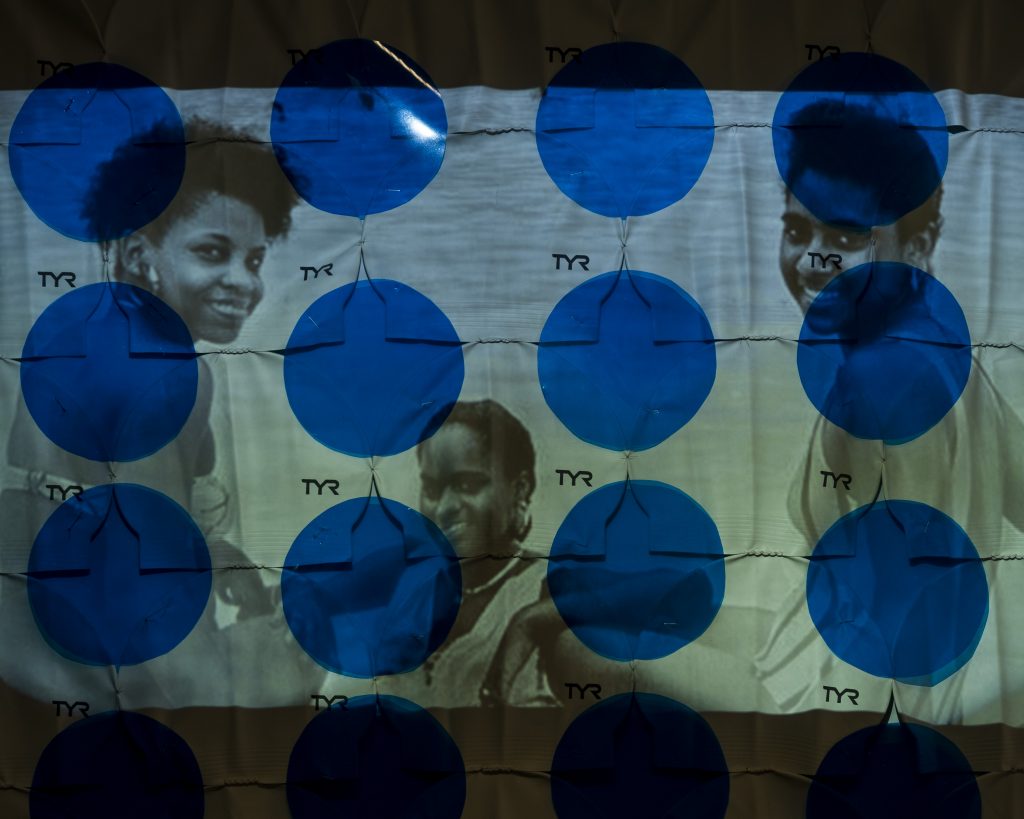
In the exhibition, you witness conduits motion towards you with goggles laced in neon lights and tentacles of illuminated strands cascading behind them like glow-in-the-dark sparklers. Are they here for me? To usher me home? You hear grainy mic feedback and muffled proclamations read from a translucent scroll. You hear songs sung with a faint syncopation to that of a hymn with little inkling of its gogo influence suspended between the call and response. McClenon and collaborators (myself as collaborator) enact what translates to be an overwater baptismal. A sacred ceremony of death and rebirth that diverges traditionally cyclical understandings of this process and points to an emergent opportunity for transformation. Like the reflective mirror paper used in drawings and collages throughout the exhibition, here again, McClenon offers a space of transparency to reflect, project, and camouflage you within the experience. Notes from VEGA imbues symbols of Black life throughout the dream-like landscape of the exhibition and recalls a familiarity that grounds and motions towards a changeability that invites improvisation and process as augmented sites of long-lasting meaning. An unsettled balancing act that fortunately McClenon shares with us on our islands of near destruction.
On my own island of what seems to be a perpetual spiral, I weather the storm. I sense the storm is bringing revelations in its wake. My intuition is correct. I see a message in a bottle calmly sailing towards me…
Notes from VEGA is a love note that I receive in gratitude over and over again.
A.J. McClenon: Notes from VEGA was on view at the Hyde Park Art Center from November 7, 2021 through January 22, 2022. Watch A.J. McClenon and Hyde Park Art Center Curatorial Fellow, Gervais Marsh, discuss McClenon’s 2021 solo exhibition, “Notes From VEGA” here.
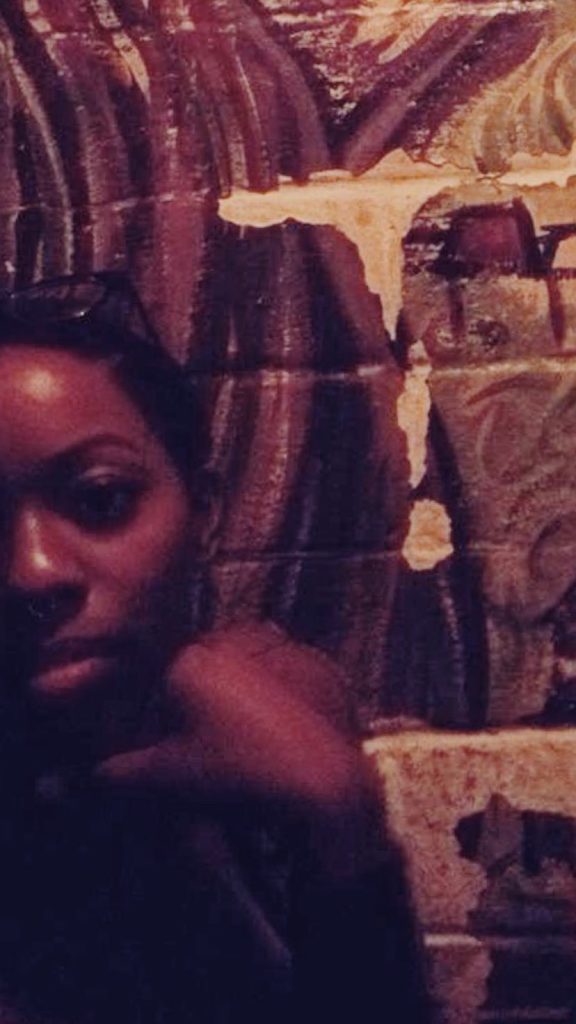
isra rene is a curator of care weaving webs of dreams tufted by our inherent connections of love, vulnerability, and care.
